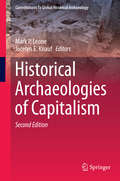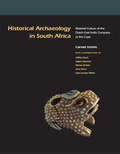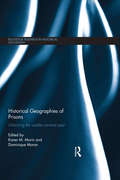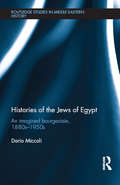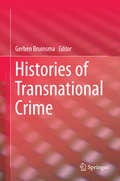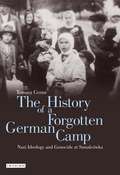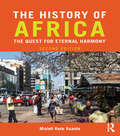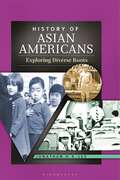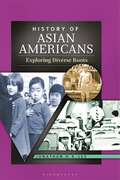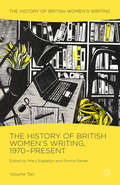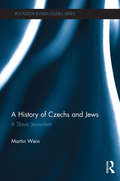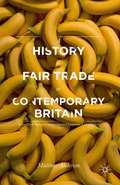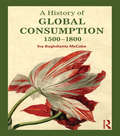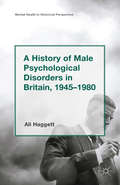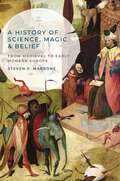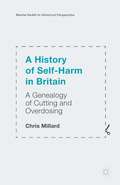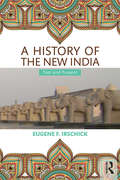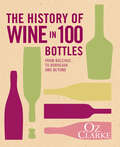- Table View
- List View
Historical Archaeologies of Capitalism (Contributions To Global Historical Archaeology)
by Mark P. Leone Jocelyn E. KnaufThis new edition of Historical Archaeologies of Capitalism shows where the study of capitalism leads archaeologists, scholars and activists. Essays cover a range of geographic, colonial and racist contexts around the Atlantic basin: Latin America and the Caribbean, North America, the North Atlantic, Europe and Africa. Here historical archaeologists use current capitalist theory to show the results of creating social classes, employing racism and beginning and expanding the global processes of resource exploitation. Scholars in this volume also do not avoid the present condition of people, discussing the lasting effects of capitalism’s methods, resistance to them, their archaeology and their point to us now.Chapters interpret capitalism in the past, the processes that make capitalist expansion possible, and the worldwide sale and reduction of people. Authors discuss how to record and interpret these. This book continues a global historical archaeology, one that is engaged with other disciplines, peoples and suppressed political and economic histories. Authors in this volume describe how new identities are created, reshaped and made to appear natural.Chapters in this second edition also continue to address why historical archaeologists study capitalism and the relevance of this work, expanding on one of the important contributions of historical archaeologies of capitalism: critical archaeology.
Historical Archaeology in South Africa: Material Culture of the Dutch East India Company at the Cape
by Carmel SchrireThis volume documents the analysis of excavated historical archaeological collections at the Cape of Good Hope, South Africa. The corpus provides a rich picture of life and times at this distant outpost of an immense Dutch seaborne empire during the contact period. Representing over three decades of excavation, conservation, and analysis, the book examines ceramics, glass, metal, and other categories of artifacts in their archaeological contexts. An enclosed CD includes a video reconstruction plus a comprehensive catalog and color illustrations of the artifacts in the corpus. The parallels and contrasts this volume reveals will help scholars studying the European expansion period to build a richer comparative picture of colonial material culture.
Historical Archaeology in South Africa: Material Culture of the Dutch East India Company at the Cape
by Carmel SchrireThis volume documents the analysis of excavated historical archaeological collections at the Cape of Good Hope, South Africa. The corpus provides a rich picture of life and times at this distant outpost of an immense Dutch seaborne empire during the contact period. Representing over three decades of excavation, conservation, and analysis, the book examines ceramics, glass, metal, and other categories of artifacts in their archaeological contexts. An enclosed CD includes a video reconstruction plus a comprehensive catalog and color illustrations of the artifacts in the corpus. The parallels and contrasts this volume reveals will help scholars studying the European expansion period to build a richer comparative picture of colonial material culture.
Historical Geographies of Prisons: Unlocking the Usable Carceral Past (Routledge Research in Historical Geography)
by Dominique Moran Karen M. MorinThis is the first book to provide a comprehensive historical-geographical lens to the development and evolution of correctional institutions as a specific subset of carceral geographies. This book analyzes and critiques global practices of incarceration, regimes of punishment, and their corresponding spaces of "corrections" from the eighteenth to twenty-first centuries. It examines individuals' experiences within various regulatory regimes and spaces of punishment, and offers an interpretation of spaces of incarceration as cultural-historical artifacts. The book also analyzes the spatial-distributional geographies of incarceration, particularly with respect to their historical impact on community political-economic development and local geographies. Contributions within this book examine a range of prison sites and the practices that take place within them to help us understand how regimes of punishment are experienced, and are constructed in different kinds of ways across space and time for very different ends. The overall aim of this book is to help understand the legacies of carceral geographies in the present. The resonances across space and time tell a profound story of social and spatial legacies and, as such, offer important insights into the prison crisis we see in many parts of the world today.
Historical Geographies of Prisons: Unlocking the Usable Carceral Past (Routledge Research in Historical Geography)
by Dominique Moran Karen M. MorinThis is the first book to provide a comprehensive historical-geographical lens to the development and evolution of correctional institutions as a specific subset of carceral geographies. This book analyzes and critiques global practices of incarceration, regimes of punishment, and their corresponding spaces of "corrections" from the eighteenth to twenty-first centuries. It examines individuals' experiences within various regulatory regimes and spaces of punishment, and offers an interpretation of spaces of incarceration as cultural-historical artifacts. The book also analyzes the spatial-distributional geographies of incarceration, particularly with respect to their historical impact on community political-economic development and local geographies. Contributions within this book examine a range of prison sites and the practices that take place within them to help us understand how regimes of punishment are experienced, and are constructed in different kinds of ways across space and time for very different ends. The overall aim of this book is to help understand the legacies of carceral geographies in the present. The resonances across space and time tell a profound story of social and spatial legacies and, as such, offer important insights into the prison crisis we see in many parts of the world today.
Histories of the Jews of Egypt: An Imagined Bourgeoisie, 1880s-1950s (Routledge Studies in Middle Eastern History)
by Dario MiccoliUp until the advent of Nasser and the 1956 War, a thriving and diverse Jewry lived in Egypt – mainly in the two cities of Alexandria and Cairo, heavily influencing the social and cultural history of the country. Histories of the Jews of Egypt argues that this Jewish diaspora should be viewed as "an imagined bourgeoisie". It demonstrates how, from the late nineteenth century up to the 1950s, a resilient bourgeois imaginary developed and influenced the lives of Egyptian Jews both in the public arena, in institutions such as the school, and in the home. From the schools of the Alliance Israélite Universelle and the Cairo lycée français to Alexandrian marriage contracts and interwar Zionist newspapers – this book explains how this imaginary was characterised by a great capacity to adapt to the evolutions of late nineteenth and early twentieth century Egypt, but later deteriorated alongside increasingly strong Arab nationalism and the political upheavals that the country experienced from the 1940s onwards. Offering a novel perspective on the history of modern Egypt and its Jews, and unravelling too often forgotten episodes and personalities which contributed to the making of an incredibly diverse and lively Jewish diaspora at the crossroads of Europe and the Middle East, this book is of interest to scholars of Modern Egypt, Jewish History and of Mediterranean History.
Histories of the Jews of Egypt: An Imagined Bourgeoisie, 1880s-1950s (Routledge Studies in Middle Eastern History)
by Dario MiccoliUp until the advent of Nasser and the 1956 War, a thriving and diverse Jewry lived in Egypt – mainly in the two cities of Alexandria and Cairo, heavily influencing the social and cultural history of the country. Histories of the Jews of Egypt argues that this Jewish diaspora should be viewed as "an imagined bourgeoisie". It demonstrates how, from the late nineteenth century up to the 1950s, a resilient bourgeois imaginary developed and influenced the lives of Egyptian Jews both in the public arena, in institutions such as the school, and in the home. From the schools of the Alliance Israélite Universelle and the Cairo lycée français to Alexandrian marriage contracts and interwar Zionist newspapers – this book explains how this imaginary was characterised by a great capacity to adapt to the evolutions of late nineteenth and early twentieth century Egypt, but later deteriorated alongside increasingly strong Arab nationalism and the political upheavals that the country experienced from the 1940s onwards. Offering a novel perspective on the history of modern Egypt and its Jews, and unravelling too often forgotten episodes and personalities which contributed to the making of an incredibly diverse and lively Jewish diaspora at the crossroads of Europe and the Middle East, this book is of interest to scholars of Modern Egypt, Jewish History and of Mediterranean History.
Histories of Transnational Crime (Studies of Organized Crime #9)
by Gerben BruinsmaHistories of Transnational Crime provides a broad, historical framework for understanding the developments in research of transnational crime over the centuries. This volume provides examples of transnational crime, and places them in a broad historical context, which has so far been missing from this field of study. The contributions to this comprehensive volume explore the causes and historical precursors of six main types of transnational crime: -piracy -human smuggling -arms trafficking -drug trafficking -art and antique trafficking -corporate crime. The historical contributions demonstrate that transnational crime is not a novel phenomenon of recent globalization and that, beyond organized crime groups, powerful individuals, governments and business corporations have been heavily involved. Through a systematic historical and contextual analysis of these types of transnational crime, the contributions to this volume provide a fundamental understanding of why and how various forms of transnational crime are still present in the contemporary world. In the past two decades, the study of transnational crime has developed from a subset of the study of organized crime to its own recognized field of study, covering distinct societal threats and requiring a particular approach.
A History of 1970s Experimental Film: Britain's Decade of Diversity
by P. Gaal-HolmesThis comprehensive historical account demonstrates the rich diversity in 1970s British experimental filmmaking, acting as a form of reclamation for films and filmmakers marginalized within established histories. An indispensable book for practitioners, historians and critics alike, it provides new interpretations of this rich and diverse history.
The History of a Forgotten German Camp: Nazi Ideology and Genocide at Szmalcówka (Genocide and Holocaust Studies)
by Tomasz CeranAlthough often overlooked, anti-Polish sentiment was central to Nazi ideology. At the outset of World War II, following the annexation of Poland, Hitler initiated a process of 'depolonization' (Entpolonisierung) which resulted in the death or displacement of a significant number of Poles living in Nazi-occupied territories. One little-known displacement camp which was critical to Hitler's plans for a 'purely German' Pomerania was 'Szmalcówka', located in Toru? in Reichsgau Danzig-West Prussia. Named after the lard ('smalec') factory in which the camp was housed, Szmalcówka was a devastating piece of machinery in Nazi racial policies. By examining policies of indirect extermination through a detailed study of Szmalcówka, Tomasz Ceran explores the terrible consequences of Nazi ideology. On the one hand this book provides an historical account, making extensive use of unique Polish sources and documents in order to describe the daily operation of Szmalcówka and the nature of indirect Nazi oppression in occupied Polish territory more generally. On the other, it provides a human insight into Nazi ideology and practice, drawing on the work of prominent intellectuals such as Hannah Arendt and Albert Camus and elaborating on numerous first-hand accounts by both perpetrators and victims of Nazi violence.Uncovering a forgotten story of World War II history, Ceran's book is essential reading for scholars and students interested in Polish history and Nazi ideology.
The History of Africa: The Quest for Eternal Harmony
by Molefi Kete AsanteThere is a paradox about Africa: it remains a subject that attracts considerable attention yet rarely is there a full appreciation of its complexity. African historiography has typically consisted of writing Africa for Europe—instead of writing Africa for itself, as itself, from its own perspectives. The History of Africa redresses this by letting the perspectives of Africans themselves take center stage. Authoritative and comprehensive, this book provides a wide-ranging history of Africa from earliest prehistory to the present day—using the cultural, social, political, and economic lenses of Africa as instruments to illuminate the ordinary lives of Africans. The result is a fresh survey that includes a wealth of indigenous ideas, African concepts, and traditional outlooks that have escaped the writing of African history in the West. The new edition includes information on the Arab Spring, the rise of FrancAfrica, the presence of the Chinese in Africa, and the birth of South Sudan. The chapters go up to the present day, addressing US President Barack Obama's policies toward Africa. A new companion website provides students and scholars of Africa with access to a wealth of supporting resources for each chapter, including images, video and audio clips, and links to sites for further research. This straightforward, illustrated, and factual text allows the reader to access the major developments, personalities, and events on the African continent. This groundbreaking survey is an indispensable guide to African history.
The History of Africa: The Quest for Eternal Harmony
by Molefi Kete AsanteThere is a paradox about Africa: it remains a subject that attracts considerable attention yet rarely is there a full appreciation of its complexity. African historiography has typically consisted of writing Africa for Europe—instead of writing Africa for itself, as itself, from its own perspectives. The History of Africa redresses this by letting the perspectives of Africans themselves take center stage. Authoritative and comprehensive, this book provides a wide-ranging history of Africa from earliest prehistory to the present day—using the cultural, social, political, and economic lenses of Africa as instruments to illuminate the ordinary lives of Africans. The result is a fresh survey that includes a wealth of indigenous ideas, African concepts, and traditional outlooks that have escaped the writing of African history in the West. The new edition includes information on the Arab Spring, the rise of FrancAfrica, the presence of the Chinese in Africa, and the birth of South Sudan. The chapters go up to the present day, addressing US President Barack Obama's policies toward Africa. A new companion website provides students and scholars of Africa with access to a wealth of supporting resources for each chapter, including images, video and audio clips, and links to sites for further research. This straightforward, illustrated, and factual text allows the reader to access the major developments, personalities, and events on the African continent. This groundbreaking survey is an indispensable guide to African history.
History of Asian Americans: Exploring Diverse Roots
by Jonathan H. LeeA comprehensive, compelling, and clearly written title that provides a rich examination of the history of Asians in the United States, covering well-established Asian American groups as well as emerging ones such as the Burmese, Bhutanese, and Tibetan American communities. History of Asian Americans: Exploring Diverse Roots supplies a concise, easy-to-use, yet comprehensive resource on Asian American history. Chronologically organized, it starts with Chinese immigration to the United States and concludes with coverage of the most recent Asian migrant populations, describing Asian American lives and experiences and documenting them as an essential part of the continuously evolving American experience and mosaic.The book discusses domestic as well as international influencing factors in Asian American history, thereby providing information within a transnational framework. An ideal resource for high school and undergraduate level students as well as general readers interested in learning about the history of Asian Americans, the chapters employ critical racialization and ethnic studies discourses that put Asian and Asian Americans subjects in an insightful comparative perspective. The book also specifically addresses the important roles played by Asian American women across history.
History of Asian Americans: Exploring Diverse Roots
by Jonathan H. LeeA comprehensive, compelling, and clearly written title that provides a rich examination of the history of Asians in the United States, covering well-established Asian American groups as well as emerging ones such as the Burmese, Bhutanese, and Tibetan American communities. History of Asian Americans: Exploring Diverse Roots supplies a concise, easy-to-use, yet comprehensive resource on Asian American history. Chronologically organized, it starts with Chinese immigration to the United States and concludes with coverage of the most recent Asian migrant populations, describing Asian American lives and experiences and documenting them as an essential part of the continuously evolving American experience and mosaic.The book discusses domestic as well as international influencing factors in Asian American history, thereby providing information within a transnational framework. An ideal resource for high school and undergraduate level students as well as general readers interested in learning about the history of Asian Americans, the chapters employ critical racialization and ethnic studies discourses that put Asian and Asian Americans subjects in an insightful comparative perspective. The book also specifically addresses the important roles played by Asian American women across history.
The History of British Women's Writing, 1970-Present: Volume Ten (History of British Women's Writing)
by Mary EagletonThis book maps the most active and vibrant period in the history of British women's writing. Examining changes and continuities in fiction, poetry, drama, and journalism, as well as women's engagement with a range of literary and popular genres, the essays in this volume highlight the range and diversity of women's writing since 1970.
A History of Czechs and Jews: A Slavic Jerusalem (Routledge Jewish Studies Series)
by Martin WeinWas Israel founded by Czechoslovakia? A History of Czechs and Jews examines this question and the resulting findings are complex. Czechoslovakia did provide critical, secret military sponsorship to Israel around 1948, but this alliance was short-lived and terminated with the Prague Trial of 1952. Israel’s "Czech guns" were German as much as Czech, and the Soviet Union strongly encouraged Czechoslovakia’s help for Israel. Most importantly however, the Czechoslovak-Israeli military cooperation was only part of a much larger picture. Since the mid-1800s, Czechs and Jews have been systematically comparing themselves to each other in literature, music, politics, diplomacy, media, and historiography. A shared perception of similar fates of two small nations trapped between East and West, in constant existential danger, helped forge a Czech-Jewish "national friendship" amid periods of estrangement. Yet, this Czech-Jewish national friendship, an idea that can be traced from Masaryk and Kafka via Weizman and Ben Gurion to Havel and Netanyahu, was more myth than reality. Relations were often mixed and highly dependent on larger historical developments affecting Central Europe and the Middle East. As the Czech Republic emerges as Israel’s main EU ally, this book provides a timely analysis of this old-new alliance and is essential reading for students and scholars with an interest in History and Jewish Studies.
A History of Czechs and Jews: A Slavic Jerusalem (Routledge Jewish Studies Series)
by Martin WeinWas Israel founded by Czechoslovakia? A History of Czechs and Jews examines this question and the resulting findings are complex. Czechoslovakia did provide critical, secret military sponsorship to Israel around 1948, but this alliance was short-lived and terminated with the Prague Trial of 1952. Israel’s "Czech guns" were German as much as Czech, and the Soviet Union strongly encouraged Czechoslovakia’s help for Israel. Most importantly however, the Czechoslovak-Israeli military cooperation was only part of a much larger picture. Since the mid-1800s, Czechs and Jews have been systematically comparing themselves to each other in literature, music, politics, diplomacy, media, and historiography. A shared perception of similar fates of two small nations trapped between East and West, in constant existential danger, helped forge a Czech-Jewish "national friendship" amid periods of estrangement. Yet, this Czech-Jewish national friendship, an idea that can be traced from Masaryk and Kafka via Weizman and Ben Gurion to Havel and Netanyahu, was more myth than reality. Relations were often mixed and highly dependent on larger historical developments affecting Central Europe and the Middle East. As the Czech Republic emerges as Israel’s main EU ally, this book provides a timely analysis of this old-new alliance and is essential reading for students and scholars with an interest in History and Jewish Studies.
A History of Fair Trade in Contemporary Britain: From Civil Society Campaigns to Corporate Compliance
by Matthew AndersonThis book offers an original contribution to the empirical knowledge of the development of Fair Trade that goes beyond the anecdotal accounts to challenge and analyse the trading practices that shaped the Fair Trade model. Fair Trade represented a new approach to global trade, corporate social responsibility and consumer politics.
A History of Global Consumption: 1500 - 1800
by Ina Baghdiantz McCabeIn A History of Global Consumption: 1500 – 1800, Ina Baghdiantz McCabe examines the history of consumption throughout the early modern period using a combination of chronological and thematic discussion, taking a comprehensive and wide-reaching view of a subject that has long been on the historical agenda. The title explores the topic from the rise of the collector in Renaissance Europe to the birth of consumption as a political tool in the eighteenth century. Beginning with an overview of the history of consumption and the major theorists, such as Bourdieu, Elias and Barthes, who have shaped its development as a field, Baghdiantz McCabe approaches the subject through a clear chronological framework. Supplemented by illlustrations in every chapter and ranging in scope from an analysis of the success of American commodities such as tobacco, sugar and chocolate in Europe and Asia to a discussion of the Dutch tulip mania, A History of Global Consumption: 1500 – 1800 is the perfect guide for all students interested in the social, cultural and economic history of the early modern period.
A History of Global Consumption: 1500 - 1800
by Ina Baghdiantz McCabeIn A History of Global Consumption: 1500 – 1800, Ina Baghdiantz McCabe examines the history of consumption throughout the early modern period using a combination of chronological and thematic discussion, taking a comprehensive and wide-reaching view of a subject that has long been on the historical agenda. The title explores the topic from the rise of the collector in Renaissance Europe to the birth of consumption as a political tool in the eighteenth century. Beginning with an overview of the history of consumption and the major theorists, such as Bourdieu, Elias and Barthes, who have shaped its development as a field, Baghdiantz McCabe approaches the subject through a clear chronological framework. Supplemented by illlustrations in every chapter and ranging in scope from an analysis of the success of American commodities such as tobacco, sugar and chocolate in Europe and Asia to a discussion of the Dutch tulip mania, A History of Global Consumption: 1500 – 1800 is the perfect guide for all students interested in the social, cultural and economic history of the early modern period.
A History of Male Psychological Disorders in Britain, 1945-1980 (Mental Health in Historical Perspective)
by Alison HaggettThis book is open access under a CC BY license and explores the under-researched history of male mental illness from the mid-twentieth century. It argues that statistics suggesting women have been more vulnerable to depression and anxiety are misleading since they underplay a host of alternative presentations of 'distress' more common in men.
A History of Science, Magic and Belief: From Medieval to Early Modern Europe
by Steven P. MarroneA History of Science, Magic and Belief is an exploration of the origins of modern society through the culture of the middle ages and early modern period. By examining the intertwined paths of three different systems for interpreting the world, it seeks to create a narrative which culminates in the birth of modernity. It looks at the tensions and boundaries between science and magic throughout the middle ages and how they were affected by elite efforts to rationalise society, often through religion. The witch-crazes of the sixteenth and seventeenth century are seen as a pivotal point, and the emergence from these into social peace is deemed possible due to the Scientific Revolution and the politics of the early modern state.This book is unique in drawing together the histories of science, magic and religion. It is thus an ideal book for those studying any or all of these topics, and with its broad time frame, it is also suitable for students of the history of Europe or Western civilisation in general.
A History of Self-Harm in Britain: A Genealogy of Cutting and Overdosing (Mental Health in Historical Perspective)
by Chris MillardThis book is open access under a CC BY license and charts the rise and fall of various self-harming behaviours in twentieth-century Britain. It puts self-cutting and overdosing into historical perspective, linking them to the huge changes that occur in mental and physical healthcare, social work and wider politics.
A History of the New India: Past and Present
by Eugene F. IrschickProviding a different approach to the history of India than previously advocated, this textbook argues that there was constant interaction between peoples and cultures. This interactive, dialogic approach provides a clear understanding of how power and social relations operated in South Asia. Covering the history of India from Mughal times to the first years of Independence, the book consists of chapters divided roughly between political and thematic questions. Topics discussed include: Mughal warfare and military developments The construction of Indian culture Indian, regional and local political articulation India’s Independence and the end of British Rule Women and governmentality The rise of the Dalit movement As well as a detailed timeline that provides a useful overview of key events in the history of India, a set of background reading is included after each chapter for readers who wish to go beyond the remit of this text. Written in an accessible, narrative style, the textbook will be suitable in courses on Indian and South Asian history, as well as courses on world history and South Asian studies.
The History of Wine in 100 Bottles: From Bacchus To Bordeaux And Beyond
by Oz ClarkeWinemaking is as old as civilization itself and wine has always been more than just a drink. For thousands of years, from its origins in ancient Mesopotamia to its current status as a vast global industry, the history of wine has been directly related to major social, cultural, religious and economic changes. This fascinating and entertaining book takes a look at 100 bottles that mark a significant change in the evolution of wine and winemaking and captures the innovations and discoveries that have had the biggest impact on the history of ‘bottled poetry’. From goatskin to the German Ratskeller casks and invention of the glass wine bottle, from the short onion-shaped bottles of the 1720s to the tall cylindrical bottles of the 1780s, why Bordeaux, Burgundy and Hoch have their own distinctive bottle shape to the distinctive Paul Masson carafe of the 1970s. Other stories cover the first cork-topped bottles to screw caps, bag-in-box, cans and cartons, early wine labels once glue was strong enough, the first wine labels to be produced by a vineyard (and not a merchant as previously) and commissioned artwork by the 20th century’s most iconic artists for labels on high-end bottles; historically important and unique bottles: the oldest unopened, the most expensive sold at auction, the rarest; wines from the oldest vineyard in production, from the driest place on earth, from the highest and lowest vineyards and the most northern and southern. Oz Clarke also writes about the people who have influenced wine through the centuries, from the medieval Cistercian monks of Burgundy who first thought of place as an important aspect of wine’s identity, through scientists like Pasteur and Peynaud who improved key technical aspects of winemaking, to 20th-century giants like Robert Mondavi and Robert Parker Jr. Oz also talks about famous vintages, from the 1727 Rüdesheimer Apostelwein to the first Montana Marlborough Sauvignon Blanc in 1979 and today’s cult wines from Bordeaux and California. Word Count – 55,000
